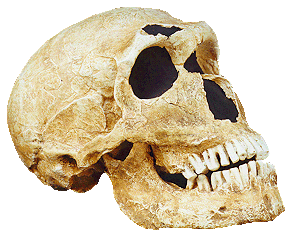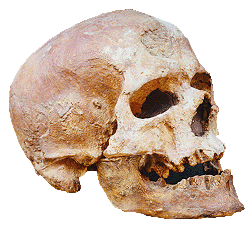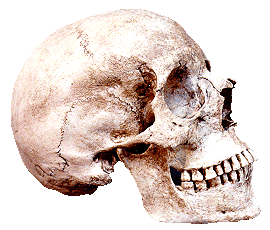




Homo sapiens

Population movements such as the colonisation of the Americas have occurred many times in human prehistory, and they inevitably muddy what might otherwise be a clear relationship between body shape and climate, and its change through time. One important example relates to the issue of the origin of modern humans. Many anthropologists believe that anatomically modern Homo sapiens evolved from a small population in Africa 200,000 years ago, and then spread into the rest of the Old World, reaching western Europe only 35,000 years ago. This is known as the "
Out of Africa" hypothesis. However, if this was true, the African origin of anatomically modern humans would be reflected in their body and limb proportions. Indeed, such populations do show this trend, as these tall, long-limbed people entered lands located at a latitude more conducive to wide bodies and short limbs.




It is mostly agreed on the overall anatomical and behavioural shifts that accompanied the evolutionary transformation from Homo erectus to Homo sapiens. Anatomically, it involved a decrease of skeletal and dental robusticity, modifications of certain functional � particularly locomotor � anatomy, and an increase in cranial volume. Behaviourally, the transition brought more finely crafted and diverse tool technologies, more efficient foraging strategies, more complex social organisation, the full development of spoken language, and artistic expression. However, one point on which an agreement has not yet been reached, is the origin of these anatomically modern humans.
This table shows the morphological differences between Homo erectus and Homo sapiens.
|
H. erectus |
Early modern Homo sapiens |
|
|
Height |
1.3 � 1.5 metres |
1.6 � 1.85 metres |
|
Physique |
Robust, but "human" skeleton |
Modern skeleton, adapted for warmth |
|
Cranial Volume |
750 � 1250 cc |
1200 � 1700 cc |
|
Known Date |
1.8 � 0.3 million years ago |
130,000 � 60,000 |
|
Distribution |
Africa, Asia and Indonesia (and Europe?) |
African and western Asia |
|
Skull form |
Flat, thick skull with large occipital and brow ridge |
Small or no brow ridge; shorter high skull |
|
Jaws/Teeth |
Robust jaw in individuals; smaller teeth than H. habilis |
Shorter jaws than Neanderthals; chin developed; teeth may be smaller |
|
Ardipithecus ramidus
|
Australopithecus anamensis
|
Australopithecus afarensis
|
|
Australopithecus africanus
|
Australopithecus aethiopicus
|
Australopithecus boisei
|
|
Australopithecus robustus
|
Homo habilis
|
Homo rudolfensis
|
Homo erectus
|
Homo ergaster
|
|
Homo heidelbergensis
|
Homo neanderthalensis
|
Homo sapiens
|